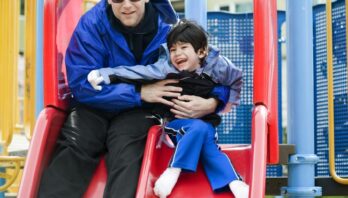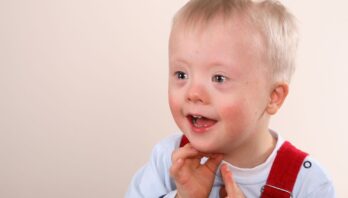Autism spectrum disorder (ASD) is a complex disability that tends to affect communication and behavior. It is 4.5 times more common in boys than girls, and tends to emerge between 2-3 years of age. It is known as a spectrum disorder because it affects people differently and in varying degrees, but children and adults with ASD are likely to have difficulties with verbal and nonverbal communication; developing, maintaining, and understanding relationships; sensory integration; repetitive behaviors; and adjusting to change.
(Adapted from Centers for Disease Control and Prevention; Autism Speaks; & Autism Society, National Institute of Mental Health.)
Tools
- Ask for and take direction from parents and other caregivers about how to approach the child and what they need.
- Avoid touching the child. Even minor physical contact can be too much and may provoke an extreme response.
- Limit input for children with ASD. Reduce noise, the number of people around the child, and visual stimulation like TV or bright or blinking lights.
- Do not require children to stop self-soothing behaviors like rocking or fidgeting with something unless they are at risk of physical injury. It is a good indicator of their levels of anxiety.
- Most children with ASD respond best to consistency and predictability. Examples:
- A time line, with five steps at the most. Start with simple instructions and build on that. First you will talk to me. 2. We’ll be here for this amount of time. 3. Then we will go talk to the nurse. 4. Then you will go home with your sister.
- Toys and other things to manipulate can help reduce agitation. For one child it may be strings or paper, others like to play with Play-Doh or soft toys.
- Using pictures, including visual schedules
- A visible clock
Communication
- The child may not respond to commands.
- Say the child’s name to get their attention, and then make your request. You may need to do this repeatedly.
- Sit next to the child, but not face to face. Talk quietly, and look for signs of response.
- Slow down. Don’t talk too much or too fast. Remain friendly.
- Repeat yourself often.
- Yelling or giving commands in a stern voice will be particularly distressing to children with ASD.
- Children with ASD comprehend at different speeds. They may understand what you are saying even though they don’t seem to be paying attention. Or they may repeat back everything you say, but not understand what it means.
- Reword what they say to see if you understood correctly. Give long wait times after you ask questions.
- Children may understand when you think they don’t. Be mindful of how you talk about them and what you say about them in their presence.
- Asking questions:
- Be as literal as possible. Rather than asking, Are you hurting anywhere? Look for signs of injury or rubbing and ask: Is your arm hurt?
- Keep questions simple and ask one thing at a time.
- Give children a choice: Were you at home or with Marcus? Did you go to the store with Mom or with Marcus? Were you with Ben or Mom?
- Be patient in their attempts to communicate with you. Read nonverbal cues.
- Use pictures. Carry a pad and pencil so you can draw what you are trying to share with children who think visually. Make a little book or lanyard of common scenes: Pictures of parent and child, child with a toy, picture of people sitting together. You can also use the pad to “script” or write what is happening. This can remove the verbal communication demands and may reduce stress and anxiety.
- If the child is stuck on one topic, listen and affirm what they are saying. It may help them move past it.
- If possible, have a support person with the child – school teacher, teaching assistant, non-abusive parent.
- Praise children with ASD for participation.
Resources
Autism Society. (2016). What is autism? Retrieved November 19, 2018, from https://www.autism-society.org/what-is/
Autism Speaks. (2018). What is autism? Retrieved November 19, 2018, from https://www.autismspeaks.org/what-autism
Centers for Disease Control and Prevention. (2018, November 15). Autism spectrum disorder. Retrieved from https://www.cdc.gov/ncbddd/autism/data.html
National Institute of Mental Health. (n.d.). Autism spectrum disorder. Retrieved November 19, 2018, from https://www.nimh.nih.gov/health/topics/autism-spectrum-disorders-asd/index.shtml
This project is funded by the Texas Center for the Judiciary through a Children’s Justice Act Grant.






